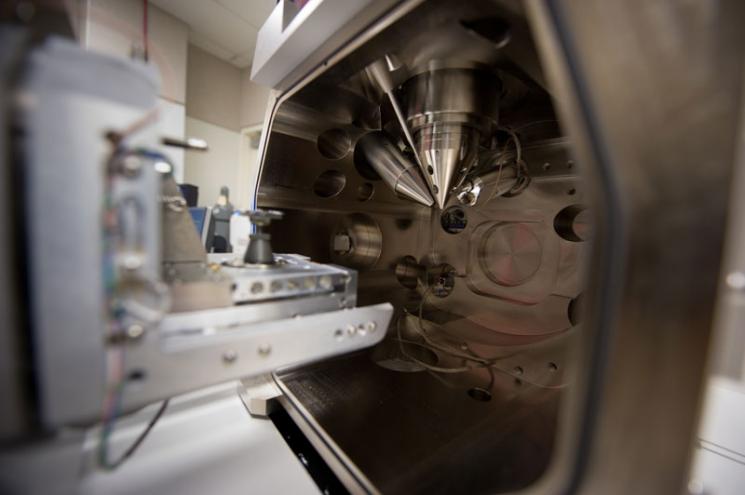
The inside of the specimen/vacuum chamber of NREL's FEI Nova 200 dual beam electron microscope used to analyze the topography of materials such as Innovalight's Silicon Ink. The instrument is used to produce site-specific sections for high spatial microstructural analysis.
In 2008, Innovalight, a solar start-up from Sunnyvale, Calif., and National Renewable Energy Technology (NREL) scientists teamed up to answer a game-changing question for potential investors: does Innovalight’s Silicon Ink actually work?
The findings: Silicon Ink delivered a low-cost, seven percent increase in power output for a typical 15 percent-efficient solar cell.
Some background: Most of the billions of solar cells made each year rely on distributing exact concentrations of dopants (impurities) throughout the cells to create electric fields. As a liquid, Silicon Ink has the unique ability to suspend silicon nanoparticles evenly in a solution, but Innovalight needed to prove that Silicon Ink can deliver dopant concentrations to the right locations without spreading everywhere or overflowing.
"They needed to prove this to their investors to show that their company was the best at doing this," NREL scientist Kirstin Alberi explained. "They didn’t know how to go about proving this, and that’s where we were able to help.”
And the latest news: in July, DuPont acquired Innovalight, advancing prospects for innovative, cost-competitive solar manufacturing in the U.S. The team includes about 60 employees.
Partnerships with businesses, from start-ups to large companies, are supported by Cooperative Research and Development Agreements (CRADAs) -- one of the examples of how the Energy Department’s National Labs are helping private industry bring cutting-edge technologies to market – creating new industries and businesses and bolstering the country’s economic competitiveness.
"We may come up with a new and innovative technology, but for it to end up on a utility scale deployment or in the fuel tank of a vehicle, there is a commercialization partner who is going to invest in the business, facilities, sales, support – all of which is done outside of the lab," says William Farris, NREL's Vice President for Commercialization & Technology Transfer.
In 2007, Lawrence Livermore National Laboratory began a CRADA partnership with Wisconsin-based TomoTherapy to develop a proton therapy system for cancer patients based on lab’s work in particle accelerators and particle beam science for nuclear security. In 2008, TomoTherapy helped launch Compact Particle Acceleration Corporation (CPAC) in Livermore to commercialize this technology.
Currently, proton treatment centers in the U.S. are about the size of a basketball arena and cost more than $100 million. CPAC’s linear accelerator will be about four meters long, require a fraction of the current cost and deliver protons more directly to the patient’s tumor – reducing impact to surrounding tissue.
In June of this year, CPAC completed construction of its first prototype proton therapy system – the venture aims to introduce this lifesaving technology to hospitals by 2014. And, the partnership continues to expand: CPAC and Lawrence Livermore have also executed a license to start commercializing other medical and telecommunications applications using this technology.
These stories are among hundreds of others illustrating the way in which the expertise of our national labs is helping solve national challenges and create new industries. Check out more on Innovalight Silicon Ink, CPAC’s proton therapy and CRADA partnerships.




